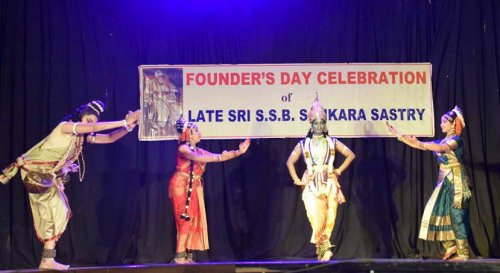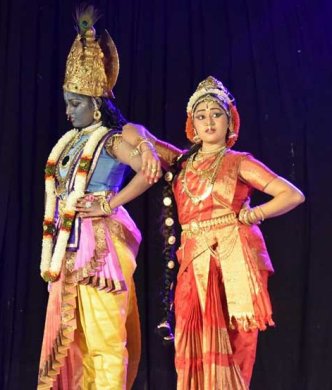
|   |

|   |
Commendable performance of 'Sri Krishna Parijatham' - Bhavanvitha Venkat e-mail: bhavanvitha@gmail.com March 28, 2016 On the occasion of Founders Day Celebrations of Visakha Music and Dance Academy, ‘Sri Krishna Parijatham’ Kuchipudi dance drama was presented on 3rd March 2016 in Kalabharati, Visakhapatnam, under the direction of Hanumantha Rao Yelamanchili (Dance Faculty, Dr. Vempati Chinna Satyam Kuchipudi Kalakshetra established by the maestro). Swarnalatha, Pratyusha, Swetha and Varshita performed in this edition as Rukmini, Narada, Satyabhama and Krishna respectively. The timeless Kuchipudi dance drama choreographed by Dr. Vempati Chinna Satyam stood the test of time and continues to be popular after fifty six years of its first performance. For an artist, performing in any of the four roles of the drama is considered an honor, a graduation in Kuchipudi. The dancers performed to recorded music and did a good job synchronizing with each beat, rhyme and step, and more importantly to the feel. It’s a fact that in the dance drama format, it’s even more difficult to perform with recorded music than to perform with live orchestra. Considering this, the young dancers did a commendable job. Each dance piece of this production provides adequate scope and opportunity to all dancers to prove all round capabilities.  The young dancers transported the rasikas into the story through this narration. Parijatha flower presented to Rukmini proves to be the reason for Satyabhama to turn her anguish towards her beloved. Feeling deeply hurt for not being considered for parijatham, she shuts herself up in her palace. Krishna enters her palace and tries to calm her anger but in the end relents and promises to bring the Parijatha Vriksham itself to her garden. This particular episode was enacted beautifully and can easily be considered the highlight of the dance drama.  Krishna fulfills his promise and convinces Satyabhama of his love for her and ends that part of the conflict. "Osi maayaladi duraasa..." brings the human nature to the fore and Satyabhama is shown once again chiding Rukmini as Sage Narada re-enters and explains through a slokam (Ashritha rakshakundu) the divine nature of Lord Krishna and the performance concludes. Varshita played the role of Sri Krishna with a measure and understanding of both expression and situation well. She should maintain eye contact during interaction with other roles even more. We see a tradition redefined for Kuchipudi as women continue to play the role of Krishna. Swarnalatha enacted the role of Rukmini. She has improved a lot in her nritta and abhinaya owing to her recent performances and dedicated training. Swetha was Satyabhama, a role every Kuchipudi artist considers a privilege to be considered for. She excelled in the piece “Jaagu cheseney" and later in the scene with Krishna where she excelled in exhibiting anger and disappointment towards him. She took time to gain confidence after her entry with pravesa daru. To overcome this, she needs to tune in to the requirements of drama right from the start. Pratyusha in the role of Narada performed well. In order to take the main roles, she needs to gain more experience in this format. Appreciation from learned people during the performance and later indicated how much the young dancers impressed the rasikas. Special appreciation should also go to Surya Rao whose make-up skills stood out. Achuta Manasa, Kuchipudi dancer and daughter of A. Ravi Chandra, was awarded by VMDA during this event. Conclusion: Dance dramas like Sri Krishna Parijatham are as rare as the Parijatha Vriksham and one hopes to see this beautiful creation being presented more and in different venues. This can be a bench mark for new dance dramas. The attention to each detail, to each music note, expression and step is only possible through consistent quality control. Creative choreographies can retain their charm over decades not just due to attention to the detail but also to the understanding of the present day teacher of the original intent. Any dilution in whatever manner would result in degradation of the work. It’s relevant to note that the “guru shishya parampara” plays a key role in order to maintain the purity of the original choreography. Here two factors, Guru Hanumantha Rao being a direct disciple of Dr. Vempati Chinna Satyam and the institute being founded by the Master, helped to present the dance drama retaining the creative art values. One good thing with the original recorded music from Kuchipudi Art Academy is the special treat that rasikas could get to listening to the voice of the maestro and the orchestra support. Not many dance dramas have the standard set these days. But in a few cases, the situation is getting better. Bhavanvitha Venkat is a writer and Kuchipudi dancer. He is a finance consultant, advisor to cultural institutes and likes to work on creative ideas. |